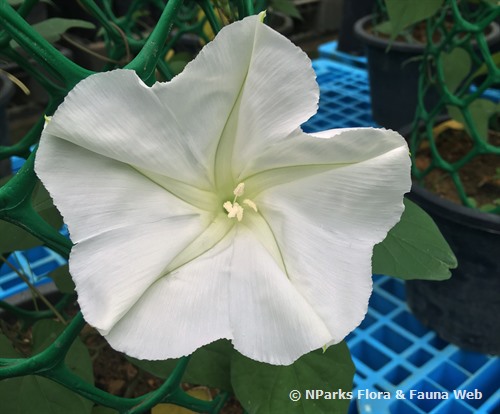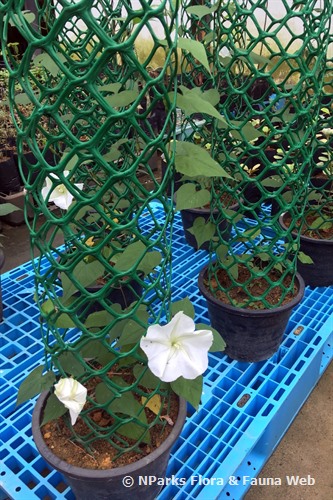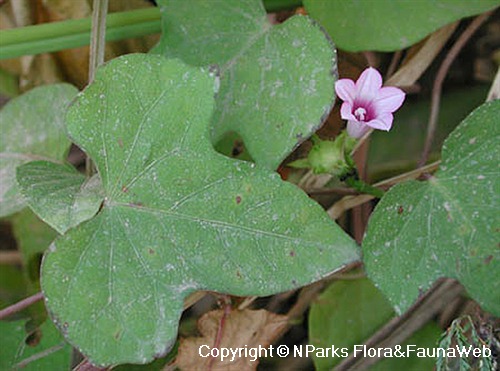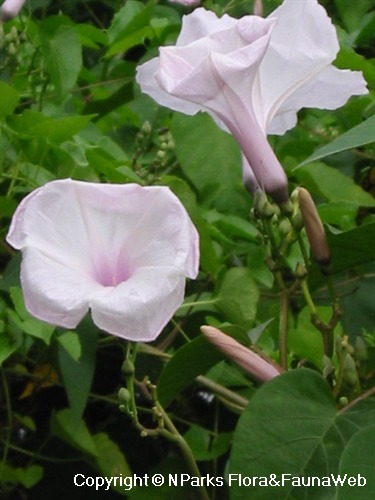
Name
Classifications and Characteristics
| Plant Division | Angiosperms (Flowering Seed Plants) |
|---|---|
| Plant Growth Form | Climber |
| Lifespan (in Singapore) | Perennial |
| Mode of Nutrition | Autotrophic |
Biogeography
| Native Distribution | Tropical America |
|---|---|
| Native Habitat | Terrestrial |
| Preferred Climate Zone | Tropical |
Description and Ethnobotany
| Growth Form | A scrambling climber which can spread up to 2 m wide. |
|---|---|
| Foliage | Deep green leaves are large, broadly ovate to heart-shaped, sometimes 3-lobed; measuring 5 - 20 cm long and 4 - 20 cm wide. The leaves are arranged alternately along the stems. Petioles are 5 - 18 cm long. |
| Stems | Produces milky sap when broken. Stems can be somewhat prickly. |
| Flowers | Flowers are large (can be up to 15 cm in diameter), trumpet-shaped, 5 white lobes with lime-green stripes, floral tube is greenish. Flowers are borne on clusters or occasionally singly, open at night and usually wither by the next morning, hence the common name. |
| Fruit | Fleshy capsule, measuring 2 -3 cm long, matures from green to dark brown or blackish in colour. The fruits split open to release four large and hairless white seeds. |
| Habitat | Found in moist forests and disturbed areas (parks and along roadsides). |
| Cultivation | It is a perennial but can be grown as an annual. Provide support or stake for plant to grow. |
| Etymology | The genus Ipomoea means worm-resembling, in reference to the twinning stems. The specific epithet alba means white, in reference to the white flowers. |
| Ethnobotanical Uses | Edible Plant Parts : Edible Roots Food (Fruit or Vegetable) |
Landscaping Features
| Desirable Plant Features | Ornamental Flowers, Fragrant (Flowers) |
|---|---|
| Landscape Uses | Parks & Gardens, Small Gardens, Trellis / Arbour / Pergola, Container Planting, Suitable for Hanging Baskets |
Fauna, Pollination and Dispersal
| Fauna Pollination Dispersal Associated Fauna | Moth Food Plant |
|---|---|
| Pollination Method(s) | Biotic (Fauna) |
| Seed or Spore Dispersal | Abiotic |
Plant Care and Propagation
| Light Preference | Full Sun, Semi-Shade |
|---|---|
| Water Preference | Moderate Water |
| Rootzone Tolerance | Moist Soils, Well-Drained Soils |
| Propagation Method | Seed, Stem Cutting, Root Cutting |
Foliar
| Foliage Retention | Evergreen |
|---|---|
| Mature Foliage Colour(s) | Green |
| Mature Foliage Texture(s) | Smooth |
| Prominent Young Flush Colour(s) | Green |
| Young Flush Texture(s) | Smooth |
| Foliar Type | Simple / Unifoliate |
| Foliar Arrangement Along Stem | Alternate |
| Foliar Attachment to Stem | Petiolate |
| Foliar Shape(s) | Non-Palm Foliage |
| Foliar Venation | Pinnate / Net |
| Foliar Margin | Entire |
| Foliar Apex - Tip | Acute |
| Foliar Base | Cordate |
Floral (Angiosperm)
| Flower & Plant Sexuality | Bisexual Flowers |
| Flower Colour(s) | White |
|---|---|
| Flower Texture(s) | Smooth |
| Flower Grouping | Solitary, Cluster / Inflorescence |
| Flower Location | Axillary |
| Flower Symmetry | Radial |
| Individual Flower Shape | Trumpet-shaped |
| Flowering Period | Free-Flowering |
Image Repository
Others
| Master ID | 33602 |
|---|---|
| Species ID | 8016 |
| Flora Disclaimer | The information in this website has been compiled from reliable sources, such as reference works on medicinal plants. It is not a substitute for medical advice or treatment and NParks does not purport to provide any medical advice. Readers should always consult his/her physician before using or consuming a plant for medicinal purposes. |


_lowres.jpg)


